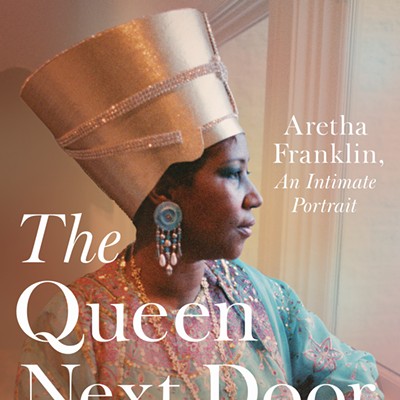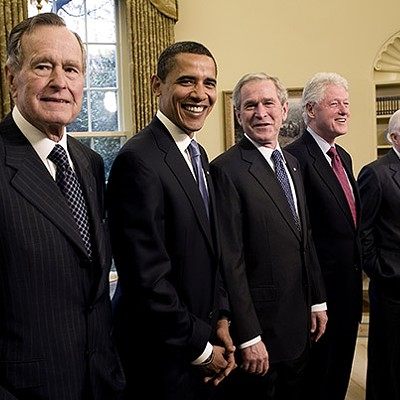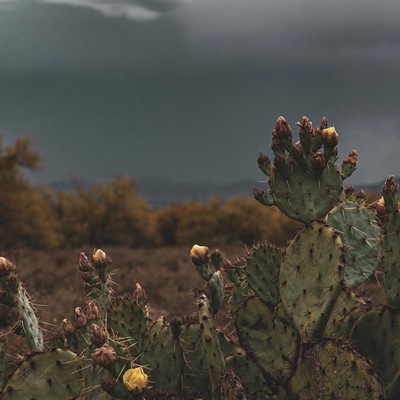"My back gate opens onto 2,000 acres of state land," he says. "I ride all over on my horse, Clay. I can really see what's going on."
And what Clay and Karl see, as they trot over the rough rollercoaster hills, is the whole cast of border characters: "Drug dealers, migrants walking the desert, the agony of people on the side of the road, Border Patrol agents, activists."
Hoffman is doubly armed when he rides into this dangerous turf.
"I carry a Nikon and a Colt .45," he declares. So far, though, he's only shot the former, a digital camera he uses to document life on the border.
His black-and-white photographs picture everybody roaming this once-sleepy landscape, along with the military hardware that's descended on it in recent years. They've appeared in U.S. News and World Report and The Indypendent in New York, as well as in a Dutch newsweekly. Starting this Saturday, they can be seen locally--sort of.
An exhibition of 30 Hoffman photos opens at the Red Rooster Café, in Arivaca, a picturesque town about 60 miles southwest of Tucson. Midway through the afternoon reception, Hoffman will show his documentary, a work in progress called Living on the Border. The DVD is a compilation of some 200 of his border images, accompanied by music and captions, but as of yet, no voiceover.
"I'm self-funded," he explains, "and I'm still learning to do narration."
Hoffman will fill in any gaps with a short introductory talk and a Q&A afterward.
Hoffman and his wife, Audrey, bought their place here four years ago, just as the quiet village was turning into the epicenter of the battle over illegal immigration.
"The militarization hadn't started yet," Hoffman says. "I got here just before."
After the Hoffmans and their kids settled in, the feds ordered up a "virtual" fence of vehicle barriers, high-sensor lights, cameras and the like, and many more miles of real fence, a 12-foot-high steel barrier snaking along the border. The number of Border Patrol agents bouncing along Arivaca's roads skyrocketed; the National Guard arrived; and the migrants kept streaming across the international line.
"I'm right here in the middle of it," Hoffman says. "It's been a fantastic experience," he adds, speaking strictly from a photographic point of view. "Lucky, too. The photo god smiled on me. The story is there. You're there. No one else is here."
Hoffman got his break when he was still relatively new to photography. For more than 35 years, he says, he was a fine jeweler, crafting high-end works in gold, silver and diamonds. He'd apprenticed with a silversmith on Cape Cod, Mass., worked in the diamond business in New York and then set up shop on a small ranch in northwest Colorado, near Steamboat Springs.
"I always liked the West," he says. "I grew up riding horses on Cape Cod. I wanted to go West. I went too far, to California, and then doubled back" to Colorado.
Eventually, he discovered photography.
"I was tired of sitting at the bench. I wanted to put more meaning into life, and get away from a bench. I bought a digital camera and fell in love with it. From the light and color of jewelry, I fell into the form, balance and composition" of photography.
A chance visit to Arivaca gave him his subject. He was in Tucson for the Gem and Mineral Show, and a friend drove him down to the border. To Hoffman, it looked like the "last frontier." He itched to record it.
"My wife said, 'If that's what you want to do, why not move to Arivaca?'" Entranced as well by the thought of no more snowplowing in Colorado's frozen winters, the couple sold their ranch, and hauling a few horses, headed south to Arizona.
Since then, Hoffman's been doing total- immersion photography--almost. He still makes some jewelry and art photographs to pay the bills.
"To get the story is to live here," he says. "I go to meetings. I go to the cantina. My wife makes wine with the local ladies. I'm building a reputation and trust."
Hoffman says he's not afraid when he's out in the desert.
"I'm savvy. I've been outdoors all my life. I keep an eye on things. I don't go in where people are hiding. I run into drug smugglers, but I mind my business and keep going. It's usually too nice a day for a gunfight and not profitable."
He often runs into migrants painstakingly picking their way through the brush.
"If you run into migrants, they nod. They go their way. You go yours. One family asked me to call the Border Patrol."
Hoffman shakes his head at U.S. border policy.
"Right now, all we're doing is shutting the border," he maintains. "We're not dealing with the millions of people here. We're not dealing with the people wanting to cross."
Mexican migrants are "family-oriented," he says. In years past, they would return to Mexico to their families, but the hardening of the line keeps them here. "Now they can't go home."
And with fearful American tourists staying away from the Mexican border towns, "We've screwed our Mexican neighbors," he argues. People say, "Honest money that was coming in, we don't get anymore." With legitimate work disappearing, Mexicans are more likely to turn to people-smuggling--or to crossing the border themselves.
Deaths of migrants are up, too. Relying on data from county medical examiners, the Coalición de Derechos Humanos counted 40 bodies recovered along the border during this year's brutal June. Last year, the group recorded 35.
In fact, fatalities are up ever since the feds cracked down. As Hoffman says, "People are diverted into the more dangerous areas."
And as an eyewitness to the continuing tragedies, that's where Hoffman brings his camera.














